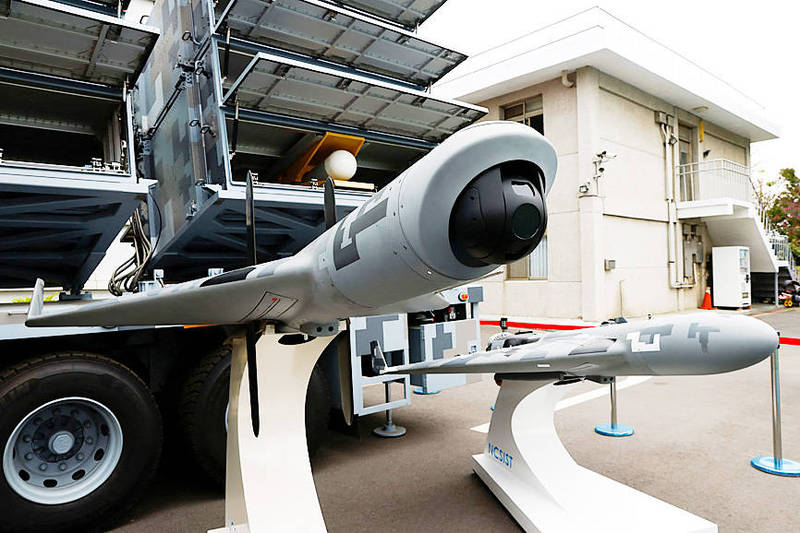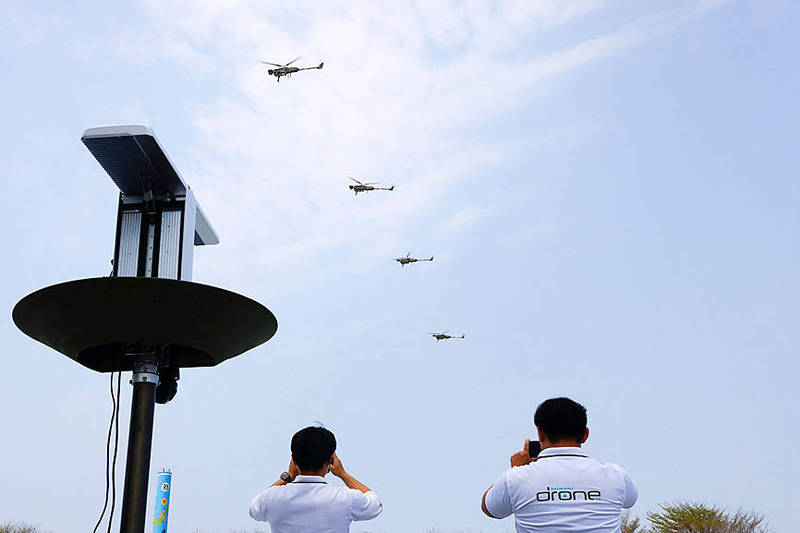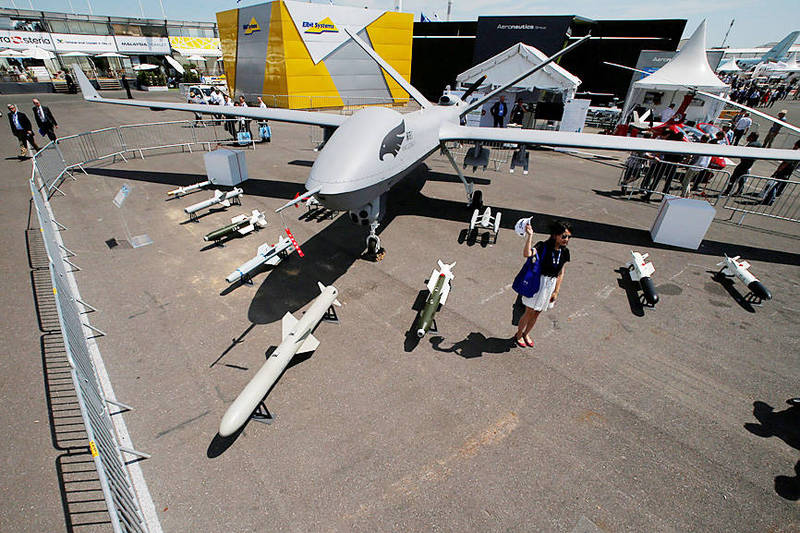《TAIPEI TIMES》 Taiwan regards drones as key to defense

Military uncrewed aerial vehicles (UAV) are exhibited during a Ministry of National Defense media visit to the Chungshan Institute of Science and Technology in Taichung on March 14. Photo: Ann Wang, Reuters
UKRAINE EFFECT: Taiwan must build up production so that it does not have to ‘cry piteously for help’ if it comes under attack, the drone project’s coordinator said
By Yimou Lee, James Pomfret and David Lague / Reuters
In the summer of last year, just months after Russia invaded Ukraine, Taiwan’s president gathered senior officials from her ruling party in Taipei. On the agenda: How was Ukraine, in its war with Russia, successfully offsetting the advantages of a much more powerful foe?
President Tsai Ing-wen (蔡英文) was given an internal 77-page briefing report. It had a clear answer: drones.
For Taiwan, though, the report painted a darker picture: The nation lagged dangerously behind its far more powerful rival, China, in arming itself with aerial drones — and needed a crash program to close the gap.
“We are far outnumbered,” said the report, a copy of which was reviewed by Reuters.
The drone gap is stark. Taiwan currently has four drone types at its disposal and a fleet size of just “hundreds,” two people with direct knowledge of the matter and a separate internal security report say.
China’s military, the People’s Liberation Army (PLA), has an arsenal of more than 50 different drone types that is estimated to run into the tens of thousands, according to defense analysts and a Reuters examination of Chinese military manufacturers and reports in Chinese state media. These drones range from jet-powered, long-range surveillance aircraft to small quadcopters deployed by ground troops.
Clearly outmatched, Tsai “pressed the button” on the creation of a strategic plan to close the gap, said a person who attended a series of meetings in which the drone strategy was forged.
Under the “Drone National Team” program, Taiwan is recruiting its commercial drone makers and aviation and aerospace firms in a joint effort with the military to fast-track the building of a self-sufficient drone supply chain.
The aim, according to a government planning document reviewed by Reuters, is to build more than 3,200 military drones by mid-2024. These include mini-drones that weigh less than 2kg as well as larger surveillance craft with a range of 150km.
To accelerate production, the government is for the first time enlisting private companies in the research and development phase of a weapons program. At least nine private firms have joined the effort.
Thunder Tiger Corp, best known for making radio-controlled model aircraft for leisure and commercial use, is typical of the type of companies recruited by the government. Participants have expertise ranging from aviation to telecommunications to the production of electronic components for applications like GPS positioning.
Hawk Yang, the head of Thunder Tiger’s Research and Development Department, said his firm is developing drones for Taiwan’s military, including pilotless ship or land-based surveillance helicopters with 4m-long rotors that have a range of 400km and can stay airborne for up to six hours.
The Ukraine war has given Taiwan “great inspiration,” the Presidential Office said in response to questions from Reuters. “In Russia’s invasion of Ukraine, the entire world saw the importance of drones.”
Taiwan’s bid to mass produce drones is part of an intensifying military rivalry that is dividing Asia, setting off a sprint to harness emerging technologies with the potential to deliver a decisive boost in firepower.
On one side are the US and its allies, including Taiwan, Australia, Japan and South Korea, who want to preserve US dominance in the region.
On the other is an increasingly assertive China, determined to gain control over Taiwan and displace the US as the leading regional power.
The US, bound by its law to provide Taiwan with the means to defend itself, has long followed a policy of “strategic ambiguity” on whether it would intervene militarily in the event of a Chinese attack.
US President Joe Biden, however, has said that US forces would defend Taiwan in the event of an invasion.
China has increasingly deployed drones as part of a campaign of gray-zone warfare — an almost daily series of intimidating air and surface operations that it has been waging around the nation in an effort to test and wear down Taiwan’s defenses.
In late April, the defense ministry tracked a Chinese combat drone, the TB-001 Twin-Tailed Scorpion, as the craft completed the first known “encirclement” by a drone of Taiwan.
As part of the plan to close the drone gap, Tsai last year ordered an assessment of Taiwan’s drone industry, two people with direct knowledge of the matter said. The study included the sourcing of industrial materials and identifying the types of drones that would suit Taiwan’s geography and military objectives. Tsai wanted to know what Taiwan needed to do to develop what military planners call a “kill chain” for drones, in which targets are identified, tracked and then destroyed, said one of the people, a senior official familiar with Taiwan’s security planning.
Aerospace entrepreneur Max Lo (羅正方), the coordinator of the drone project, said he delivered the presentation to Tsai in June last year.
The presentation said Ukraine had used drones to conduct “asymmetrical warfare” and surprise attacks. It advised that Taiwan aim to become a major exporter of drone components and a research and development center for this technology in Asia, with the government coordinating efforts. Taiwan should accelerate mass production of a range of military drones to boost self-reliance in the struggle with Beijing, it said.
Lo said the nation must build up a production line so it does not have to “cry piteously for help from others” if it comes under attack. It must avoid relying on the so-called “red supply chain” — components sourced from China.
The US, Taiwan’s main ally, has the world’s most advanced military drones, defense analysts say. This includes an arsenal of more than 11,000 of these aircraft in service with the army, air force, navy and marines, according to the Pentagon. US drones range in size from 2kg hand-launched drones to 14,500kg long-range surveillance drones. US allies Japan, Australia and South Korea also field aerial drones in their forces.
In the event of a war over Taiwan, however, US drones would need to be dispatched from outside the conflict zone. There are no US or allied combat forces stationed in Taiwan, so the nation would have to rely on its domestic fleet, at least in the early stages of an attack or invasion, military analysts interviewed by Reuters say.
Longer-range US and allied strike and surveillance drones could be deployed from bases in Japan and the Pacific if Washington and its allies decided to intervene in a conflict, they said.
And China is catching up.
Tai Ming Cheung, an expert on the Chinese military at the University of California in the US, said that while the US maintains an advantage in drone capability, China has become more competitive because of the country’s high degree of commercial-military fusion.
Unlike Taiwan, China began mass-producing uncrewed aircraft long before the Ukraine war. The PLA drone development program began in the 1960s, when China developed the Chang Kong-1 (Vast Sky), a radio-controlled uncrewed target aircraft adapted from earlier Soviet-supplied models.
The impetus for drone development comes from the top. At the 20th Party Congress in October last year, Chinese President Xi Jinping (習近平) said Beijing would accelerate the “development of unmanned, intelligent combat capabilities.”
Xi began a major modernization of the PLA after taking power over a decade ago. This has led to advances in drones as well as fighter jets, missiles and satellites.
Today, China has virtually cornered the global commercial drone market, accounting for an estimated 80 percent of sales, according to some industry estimates. This is a key advantage for the PLA, which can draw on this vast commercial drone industry for technical assistance, equipment suppliers and off-the-shelf models.
Still, there is little public information about the contribution drones now make to PLA operations. China’s Ministry of Defense has never released figures on the size of its drone fleet. In a 2015 report, the US Department of Defense cited estimates that the PLA would have manufactured upwards of 40,000 drones by the end of this year.
In its annual report on China’s military power, the Pentagon last year said the PLA is deploying “ever more sophisticated” aerial drones.
One focus for the Chinese military is the potential launch of “drone swarms” — large numbers of drones powered by artificial intelligence and acting in concert as they attack targets.
SUICIDE DRONES
While arming the PLA, China’s drone makers have also captured a growing share of the international market. At China’s showcase for cutting-edge weapons, the Zhuhai air show, Beijing unveiled its latest pilotless systems in November last year, including its most advanced combat and reconnaissance drone: the Wing Loong 3. The intercontinental drone has a 10,000km range, according to Chinese media reports. Also on display were swarm drone systems and anti-drone defenses.
In a conflict with Taiwan, China’s high-altitude drones could be deployed to gather intelligence on the nation’s mobile missile batteries and other assets, according to Shu Hsiao-huang (舒孝煌), a researcher at the Institute for National Defense and Security Research.
For air and sea supremacy, the PLA could then deploy tactical drones to track, target and destroy Taiwan’s mobile and land-based missile launchers, he said.
China could also turn its retired fighter jets into suicide drones that could fly into Taiwanese airspace and “consume” its air defense missiles by drawing fire, he said.
While Taiwan gears up to build a drone pipeline, it is also planning measures to offset China’s advantage in numbers. Local companies are working on counter-drone technology, including interceptor drones.
If the enemy sends in “hundreds of drones all at once, we need to be able to identify them and assign missions,” said Wang Yu-jiu, chairman and CEO of Tron Future, which is developing anti-drone devices such as jammers that can disable incoming drones. “This is a war of technology.”
新聞來源:TAIPEI TIMES

People take pictures of Thunder Tiger Group’s uncrewed aerial vehicles (UAV) during a demonstration at the Asia UAV AI Innovation Application R&D Center in Chiayi County on March 30. Photo: Ann Wang, Reuters

China’s Wing Loong II drone is seen on static display during the 52nd Paris Air Show at Le Bourget Airport near Paris on June 20, 2017. Photo: Reuters











